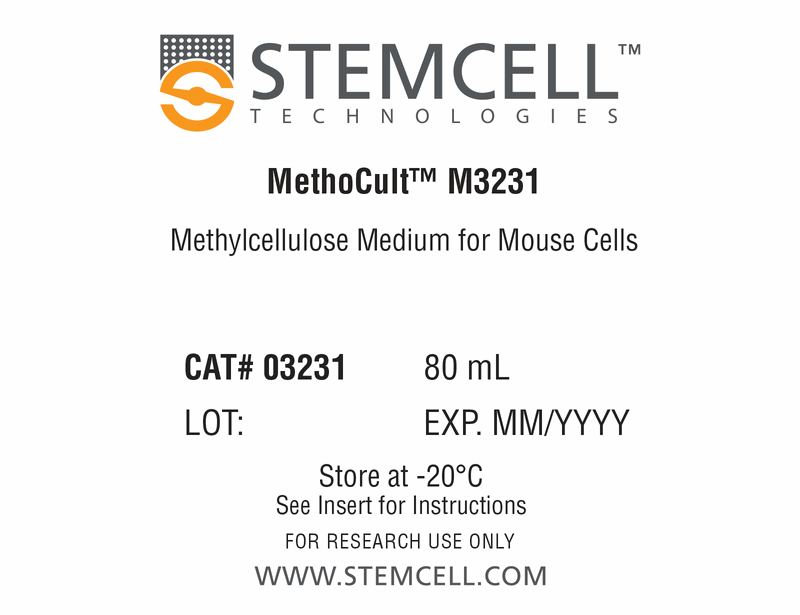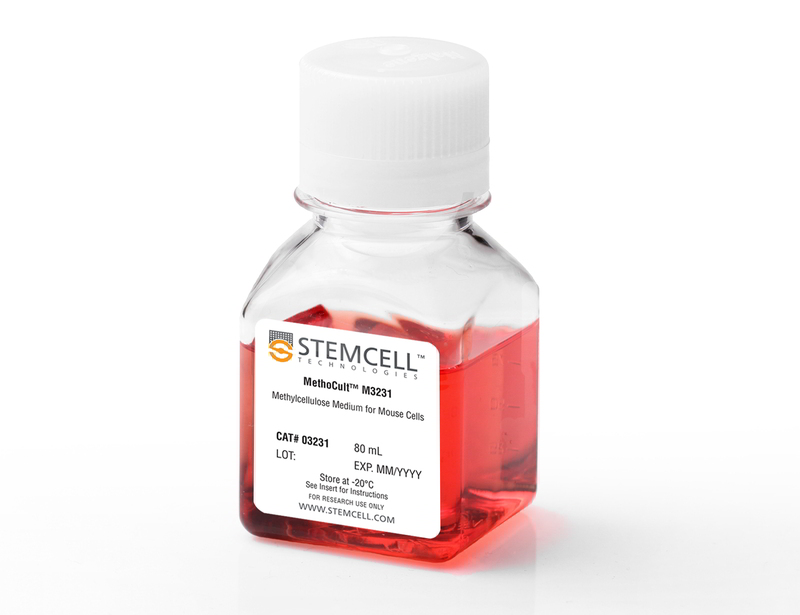MethoCult™ M3231
Methylcellulose-based medium without cytokines for mouse cells
概要
MethoCult™ M3231 is an incomplete medium formulation that contains methylcellulose in Iscove's MDM. MethoCult™ M3231 is suitable for the growth and enumeration of hematopoietic progenitor cells in colony-forming unit (CFU) assays of mouse bone marrow, spleen, peripheral blood, and fetal liver, when the appropriate growth factors and supplements are added. This formulation does not contain erythropoietin or other cytokines.
Browse our Frequently Asked Questions (FAQs) on performing the CFU assay.
Browse our Frequently Asked Questions (FAQs) on performing the CFU assay.
Contains
• Methylcellulose in Iscove's MDM
• Fetal bovine serum
• Bovine serum albumin
• 2-Mercaptoethanol
• Supplements
• Fetal bovine serum
• Bovine serum albumin
• 2-Mercaptoethanol
• Supplements
Subtype
Semi-Solid Media, Specialized Media
Cell Type
Hematopoietic Stem and Progenitor Cells
Species
Mouse
Application
Cell Culture, Colony Assay, Functional Assay
Brand
MethoCult
Area of Interest
Stem Cell Biology
技术资料
| Document Type | 产品名称 | Catalog # | Lot # | 语言 |
|---|---|---|---|---|
| Product Information Sheet | MethoCult™ M3231 | 03231 | All | English |
| Manual | MethoCult™ M3231 | 03231 | All | English |
| Safety Data Sheet | MethoCult™ M3231 | 03231 | All | English |
数据及文献
Publications (41)
Leukemia 2019 jul
Twins with different personalities: STAT5B-but not STAT5A-has a key role in BCR/ABL-induced leukemia.
Abstract
Abstract
Deregulation of the Janus kinase/signal transducers and activators of transcription (JAK/STAT) signaling pathway is found in cancer with STAT5A/B controlling leukemic cell survival and disease progression. As mutations in STAT5B, but not STAT5A, have been frequently described in hematopoietic tumors, we used BCR/ABL as model systems to investigate the contribution of STAT5A or STAT5B for leukemogenesis. The absence of STAT5A decreased cell survival and colony formation. Even more drastic effects were observed in the absence of STAT5B. STAT5B-deficient cells formed BCR/ABL+ colonies or stable cell lines at low frequency. The rarely evolving Stat5b-/- cell lines expressed enhanced levels of BCR/ABL oncoprotein compared to wild-type cells. In line, Stat5b-/- leukemic cells induced leukemia with a significantly prolonged disease onset, whereas Stat5a-/- cells rapidly caused a fatal disease superimposable to wild-type cells. RNA-sequencing (RNA-seq) profiling revealed a marked enhancement of interferon (IFN)-alpha and IFN-gamma signatures in Stat5b-/- cells. Inhibition of IFN responses rescued BCR/ABL+ colony formation of Stat5b-/--deficient cells. A downregulated IFN response was also observed in patients suffering from leukemia carrying STAT5B mutations. Our data define STAT5B as major STAT5 isoform driving BCR/ABL+ leukemia. STAT5B enables transformation by suppressing IFN-alpha/gamma, thereby facilitating leukemogenesis. Our findings might help explain the high frequency of STAT5B mutations in hematopoietic tumors.
Cell stem cell 2019 jul
Targeting the RNA m6A Reader YTHDF2 Selectively Compromises Cancer Stem Cells in Acute Myeloid Leukemia.
Abstract
Abstract
Acute myeloid leukemia (AML) is an aggressive clonal disorder of hematopoietic stem cells (HSCs) and primitive progenitors that blocks their myeloid differentiation, generating self-renewing leukemic stem cells (LSCs). Here, we show that the mRNA m6A reader YTHDF2 is overexpressed in a broad spectrum of human AML and is required for disease initiation as well as propagation in mouse and human AML. YTHDF2 decreases the half-life of diverse m6A transcripts that contribute to the overall integrity of LSC function, including the tumor necrosis factor receptor Tnfrsf2, whose upregulation in Ythdf2-deficient LSCs primes cells for apoptosis. Intriguingly, YTHDF2 is not essential for normal HSC function, with YTHDF2 deficiency actually enhancing HSC activity. Thus, we identify YTHDF2 as a unique therapeutic target whose inhibition selectively targets LSCs while promoting HSC expansion.
Nature genetics 2019
Genomic subtyping and therapeutic targeting of acute erythroleukemia.
Abstract
Abstract
Acute erythroid leukemia (AEL) is a high-risk leukemia of poorly understood genetic basis, with controversy regarding diagnosis in the spectrum of myelodysplasia and myeloid leukemia. We compared genomic features of 159 childhood and adult AEL cases with non-AEL myeloid disorders and defined five age-related subgroups with distinct transcriptional profiles: adult, TP53 mutated; NPM1 mutated; KMT2A mutated/rearranged; adult, DDX41 mutated; and pediatric, NUP98 rearranged. Genomic features influenced outcome, with NPM1 mutations and HOXB9 overexpression being associated with a favorable prognosis and TP53, FLT3 or RB1 alterations associated with poor survival. Targetable signaling mutations were present in 45{\%} of cases and included recurrent mutations of ALK and NTRK1, the latter of which drives erythroid leukemogenesis sensitive to TRK inhibition. This genomic landscape of AEL provides the framework for accurate diagnosis and risk stratification of this disease, and the rationale for testing targeted therapies in this high-risk leukemia.
Blood 2011 MAR
In vitro assays misrepresent in vivo lineage potentials of murine lymphoid progenitors.
Abstract
Abstract
The identity of T-cell progenitors that seed the thymus has remained controversial, largely because many studies differ over whether these progenitors retain myeloid potential. Contradictory reports diverge in their use of various in vitro and in vivo assays. To consolidate these discordant findings, we compared the myeloid potential of 2 putative thymus seeding populations, common lymphoid progenitors (CLPs) and multipotent progenitors (MPPs), and the earliest intrathymic progenitor (DN1), using 2 in vitro assays and in vivo readouts. These assays gave contradictory results: CLP and DN1 displayed surprisingly robust myeloid potential on OP9-DL1 in vitro stromal cocultures but displayed little myeloid potential in vivo, as well as in methylcellulose cultures. MPP, on the other hand, displayed robust myeloid potential in all settings. We conclude that stromal cocultures reveal cryptic, but nonphysiologic, myeloid potentials of lymphoid progenitors, providing an explanation for contradictory findings in the field and underscoring the importance of using in vivo assays for the determination of physiologic lineage potentials.
Blood 2011 MAR
Novel imatinib-sensitive PDGFRA-activating point mutations in hypereosinophilic syndrome induce growth factor independence and leukemia-like disease.
Abstract
Abstract
The FIP1L1-PDGFRA fusion is seen in a fraction of cases with a presumptive diagnosis of hypereosinophilic syndrome (HES). However, because most HES patients lack FIP1L1-PDGFRA, we studied whether they harbor activating mutations of the PDGFRA gene. Sequencing of 87 FIP1L1-PDGFRA-negative HES patients revealed several novel PDGFRA point mutations (R481G, L507P, I562M, H570R, H650Q, N659S, L705P, R748G, and Y849S). When cloned into 32D cells, N659S and Y849S and-on selection for high expressors-also H650Q and R748G mutants induced growth factor-independent proliferation, clonogenic growth, and constitutive phosphorylation of PDGFRA and Stat5. Imatinib antagonized Stat5 phosphorylation. Mutations involving positions 659 and 849 had been shown previously to possess transforming potential in gastrointestinal stromal tumors. Because H650Q and R748G mutants possessed only weak transforming activity, we injected 32D cells harboring these mutants or FIP1L1-PDGFRA into mice and found that they induced a leukemia-like disease. Oral imatinib treatment significantly decreased leukemic growth in vivo and prolonged survival. In conclusion, our data provide evidence that imatinib-sensitive PDGFRA point mutations play an important role in the pathogenesis of HES and we propose that more research should be performed to further define the frequency and treatment response of PDGFRA mutations in FIP1L1-PDGFRA-negative HES patients.
Blood 2011 MAR
Activation of the unfolded protein response is associated with impaired granulopoiesis in transgenic mice expressing mutant Elane.
Abstract
Abstract
Severe congenital neutropenia (SCN) is an inborn disorder of granulopoiesis that in many cases is caused by mutations of the ELANE gene, which encodes neutrophil elastase (NE). Recent data suggest a model in which ELANE mutations result in NE protein misfolding, induction of endoplasmic reticulum (ER) stress, activation of the unfolded protein response (UPR), and ultimately a block in granulocytic differentiation. To test this model, we generated transgenic mice carrying a targeted mutation of Elane (G193X) reproducing a mutation found in SCN. The G193X Elane allele produces a truncated NE protein that is rapidly degraded. Granulocytic precursors from G193X Elane mice, though without significant basal UPR activation, are sensitive to chemical induction of ER stress. Basal and stress granulopoiesis after myeloablative therapy are normal in these mice. Moreover, inaction of protein kinase RNA-like ER kinase (Perk), one of the major sensors of ER stress, either alone or in combination with G193X Elane, had no effect on basal granulopoiesis. However, inhibition of the ER-associated degradation (ERAD) pathway using a proteosome inhibitor resulted in marked neutropenia in G193X Elane. The selective sensitivity of G913X Elane granulocytic cells to ER stress provides new and strong support for the UPR model of disease patho-genesis in SCN.


